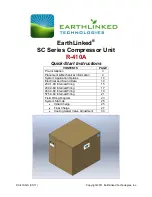
AGL_Stream_ST_A2L_A1_4M_6M_EN_Rev00
5
To recharge:
▪
When the compressor is completely empty of oil, the amount of oil to be "recharged" is typically
0.12 litre less than the original oil charge (oil will already be present in the system).
To top up:
▪
During commissioning, planned maintenance or servicing, add oil so that the compressor oil level
is between min ¼ and max ¾ of sight glass.
2.4.2 Application limits
CAUTION
Inadequate lubrication! Compressor breakdown!
The superheat at the
compressor suction inlet must always be sufficient to ensure that no refrigerant
droplets enter the compressor. For a typical evaporator-expansion valve
configuration a minimum stable superheat of at least 5 K is required.
For application envelopes and technical data, please refer to Select software available at
2.4.3 PED category and maximum allowable pressure PS
The Pressure Equipment Directive PED 2014/68/EU does not apply to Stream 4M* and 6M* semi-
hermetic compressors.
The pressure PS is the maximum allowable pressure at the low- and high-pressure sides of the
compressor. The maximum pressure value PS for the individual compressor type is printed on the
nameplate of the compressor. Safety is established in compliance with the relevant standards
applicable to the given product. Also refer to
section 3.2.3 "Maximum allowable pressures"
.
Compressor
PS
High-pressure side
PS
Low-pressure side
4M* and 6M*
32.5 bar(g)
22.5 bar(g)
Table 3: Maximum allowable pressures
2.5 Design features
2.5.1 Compressor construction
All compressors are fitted with Stream valve plates. This is a unique Emerson valve plate design
which is comparable to
Discus™ valve plates. To maintain the high capacity of these compressors
in case of exchange, make sure to always select the correct valve-plate-to-body gasket.
Each cylinder head has 2 plugged 1/8" - 27 NPTF
tapped holes for connecting high-pressure
switches.
High-pressure switches must be calibrated and
tested before putting the compressor into
service. They must stop the compressor if the
allowable pressure is exceeded.
The cylinder head area above the valve plate is
completely under discharge pressure.
Figure 2: Stream design
2.5.2 Compressor cooling
Compressor motors must always be cooled, and cylinder head cooling may also be needed at certain
operating conditions.
All Stream compressors are suction-gas-cooled. With suction-gas-cooled compressors, the motor is
cooled by the incoming refrigerant, which enters the compressor and is then passed over the motor
area. An additional fan may be required depending upon the operating conditions
– see Select
NOTE: The operation of the additional fan can be controlled by the Copeland
™ compressor
electronics module (dedicated extension module C to be ordered).









































